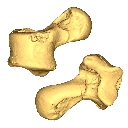















| Plane | Position | Flip |
| Show planes | Show edges |
Measured length
0.0
0.0
M3#380
Right talus 3D surface of a Miocene Cebinae indet. primate
Data citation:
Laurent Marivaux , Rodolfo Salas-Gismondi
and Pierre-Olivier Antoine
, 2019. M3#380. doi: 10.18563/m3.sf.380
Model solid/transparent

|
3D model related to the publication: A platyrrhine talus from the early Miocene of Peru (Amazonian Madre de Dios Sub-Andean Zone)Laurent Marivaux, Rodolfo Salas-Gismondi and Pierre-Olivier AntoinePublished online: 30/01/2019Keywords: Cebidae Cebinae; Neogene; Primates; South America; Tarsal bone https://doi.org/10.18563/journal.m3.85 Abstract This contribution contains the 3D model of the fossil talus of a small-bodied anthropoid primate (Platyrrhini, Cebidae, Cebinae) discovered from lower Miocene deposits of Peruvian Amazonia (MD-61 locality, Upper Madre de Dios Basin). This fossil was described and figured in the following publication: Marivaux et al. (2012), A platyrrhine talus from the early Miocene of Peru (Amazonian Madre de Dios Sub-Andean Zone). Journal of Human Evolution. http://dx.doi.org/10.1016/j.jhevol.2012.07.005 See original publication M3 article infos Published in Volume 05, issue 01 (2019) |
|